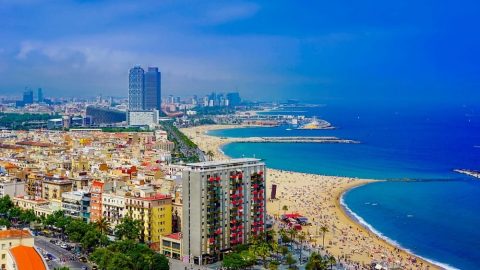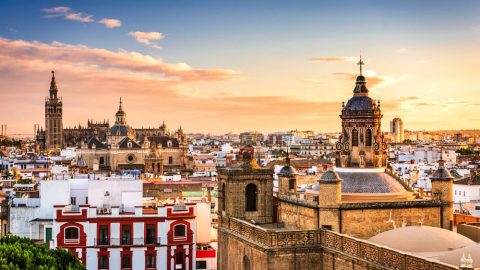(CNN) — The US Centers for Disease Control and Prevention moved five Caribbean island destinations into its highest-risk travel category for Covid-19 on Monday.
In total, the CDC moved 15 places to Level 4, or “very high” risk, showing the continuing grip the Omicron variant of the coronavirus has on the world right now. Last week, 22 destinations were added to Level 4.
The CDC places a destination at Level 4 when more than 500 cases per 100,000 residents are registered in the past 28 days. The CDC advises travelers to avoid travel to Level 4 countries.
The 15 places added this week are:
• Colombia
• Costa Rica
• Dominican Republic
• Fiji
• Guadeloupe
• Jamaica
• Kuwait
• Mongolia
• Niger
• Peru
• Romania
• Saint Barthélemy
• Saint Martin
• Tunisia
• United Arab Emirates
The Caribbean island destinations — the Dominican Republic, Guadeloupe, Jamaica, Saint Barthélemy and Saint Martin — represented one third of the new entries this week. Haiti, which is located on the island of Hispaniola alongside the Dominican Republic, was already at Level 4. And French Saint Martin also shares an island with Dutch Sint Maarten, which was already at Level 4.
Other popular Caribbean destinations were also already at Level 4. They include Aruba, the Bahamas, Barbados, the British Virgin Islands, Curaçao and Turks and Caicos, among others.
Two mainland countries with Caribbean coastlines — Costa Rica in Central America and Colombia in South America — are on Level 4 as well.

The Incan site of Machu Picchu is Peru’s most famous tourist spot. On Monday, Peru moved into the CDC’s highest-risk level for Covid-19.
Ernesto Benavides/AFP via Getty Images
Other notable travel hot spots added to Level 4 this week that the CDC suggests travelers avoid: Peru, home to Machu Picchu, and the United Arab Emirates, where Dubai is located.
Last week, 14 of the 15 destinations were on Level 3, which is considered “high” risk for Covid-19.
Niger, a landlocked nation in West Africa best known for its ancient caravan cities, had been at Level 1, considered “low” risk.
Situation in Europe
While more of the Caribbean is moving into Level 4 this week, almost all of Europe has remained firmly lodged there for weeks or months now. Those places include some of the continent’s biggest names.
• France
• Germany
• Greece
• Iceland
• Ireland
• Italy
• Spain
• United Kingdom
Romania is the only new European addition to Level 4 this week.
Level 3 additions

The Taj Mahal mausoleum is the iconic symbol of India, which has had wide swings with Covid-19. India’s Omicron cases are rising, and it’s moved up to the CDC’s Level 3.
Ludovic Marin/AFP via Getty Images
The Level 3 category — which applies to destinations that have had between 100 and 500 cases per 100,000 residents in the past 28 days — saw 10 additions on Monday:
• Djibouti
• Equatorial Guinea
• Guatemala
• India
• Japan
• Kosovo
• Kyrgyzstan
• Mali
• Republic of the Congo
• Senegal
Four of the destinations — Equatorial Guinea in Central Africa; Japan; Kyrgyzstan in Central Asia; and Senegal in West Africa — had been at the “low” risk Level 1.
The remaining six had been at Level 2.
Levels 2, 1 and unknown
Destinations carrying the “Level 2: Covid-19 Moderate” designation have seen 50 to 99 Covid-19 cases per 100,000 residents in the past 28 days. That level saw only two new additions on Monday.
They were Bangladesh, which had been at Level 1, and tiny sultanate of Brunei, which had been “unknown” last week.
To be in “Level 1: Covid-19 Low,” a destination must have fewer than 50 new cases per 100,000 residents over the past 28 days. No new additions were made on Monday.
China, which is hosting the Winter Olympic Games in February, has been on Level 1 since May 2021. It’s one of only a dozen destinations currently at Level 1.
Finally, there are destinations for which the CDC has an “unknown” risk because of a lack of information. Usually, but not always, these are small, remote places or places with ongoing warfare or unrest. There were no additions this week.
Among the popular destinations in “unknown” risk are Cambodia, French Polynesia and Tanzania. The CDC advises against travel to these places precisely because the risks are unknown.
Cruising

A docked Norwegian Gem cruise ship is seen at the Port of Miami in 2021.
Chandan Khanna/AFP/Getty Images
On December 30, the CDC increased the risk for cruise ship travel to Level 4 and said it should be avoided, regardless of vaccination status. It remained at Level 4 in the newest update.
Considerations for travel
Transmission rates are important to consider when making travel decisions, but there are other factors to weigh as well, according Dr. Leana Wen, a CNN medical analyst, emergency physician and professor of health policy and management at the George Washington University Milken Institute School of Public Health.
“The transmission rates are one guidepost,” Wen said. “Another is what precautions are required and followed in the place that you’re going and then the third is what are you planning to do once you’re there.
“Are you planning to visit a lot of attractions and go to indoor bars? That’s very different from you’re going somewhere where you’re planning to lie on the beach all day and not interact with anyone else. That’s very different. Those are very different levels of risk.”
Vaccination is the most significant safety factor for travel since unvaccinated travelers are more likely to become ill and transmit Covid-19 to others, Wen said.
She said people should be wearing a high-quality mask — N95, KN95 or KF94 — anytime they’re in crowded indoor settings with people of unknown vaccination status.
Before you travel, it’s also important to consider what you would do if you end up testing positive away from home, Wen said. Where will you stay and how easy will it be to get a test to return home?
Top image: Tourists enjoy a beach in Punta Cana in the Dominican Republic on January 7. (Photo by Erika Santelices / AFP via Getty Images)





Recent Comments